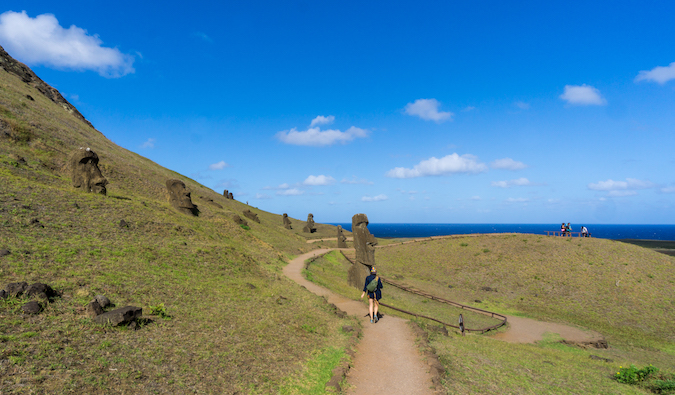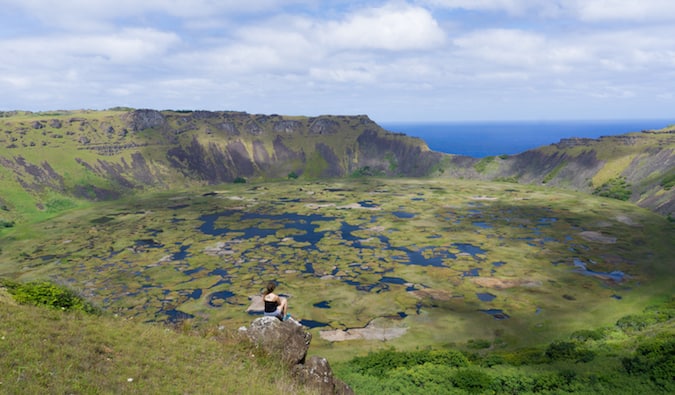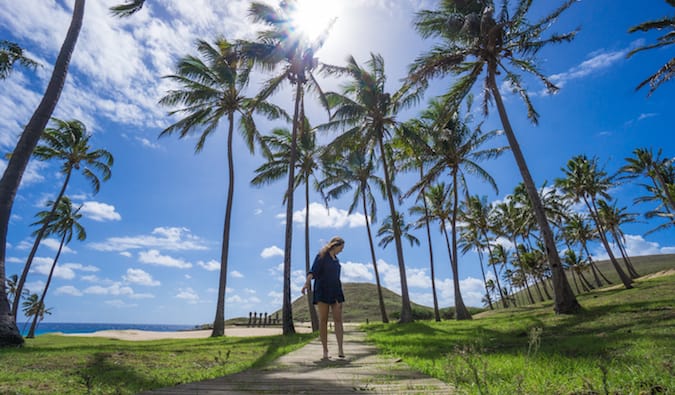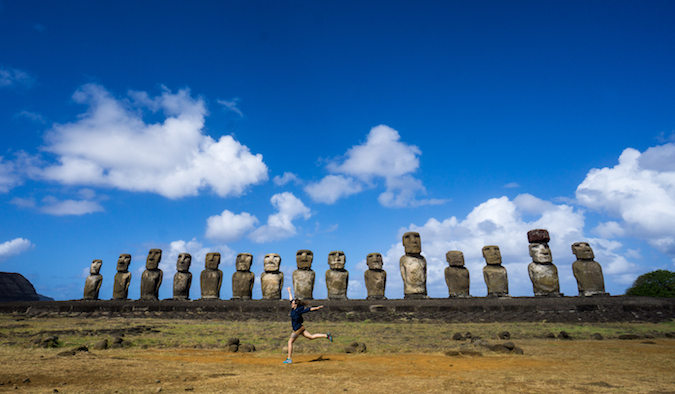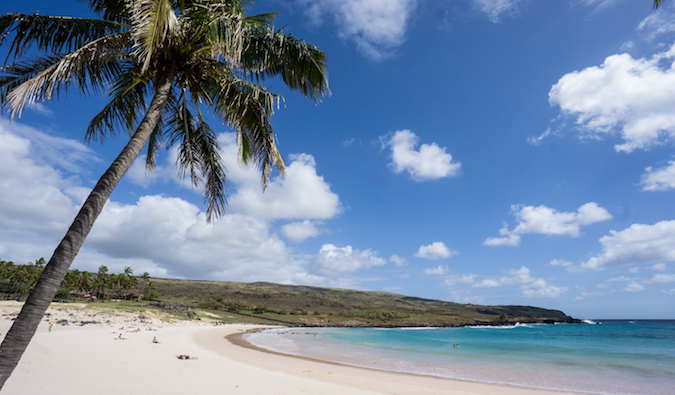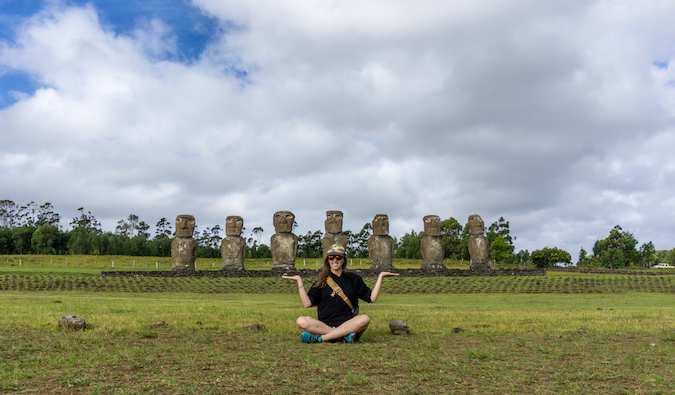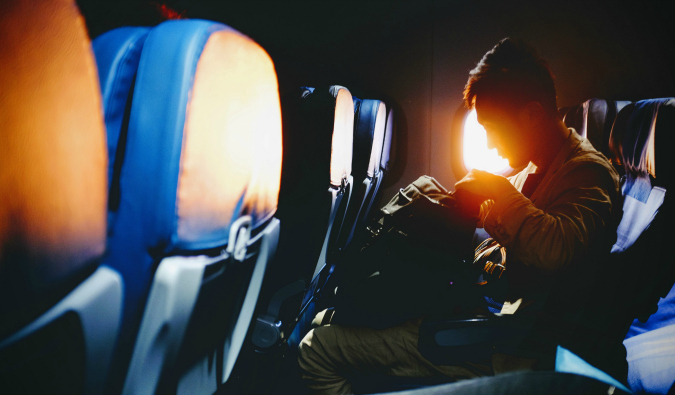
Updated: 12/18/18 | December 18th, 2018
Most people aren’t born savvy travelers. It’s something that only comes with on-the-road experience.
In the beginning, you make a lot of travel mistakes.
Travel savviness is a process born of missed buses, foolish behavior, cultural unawareness, and countless tiny errors. Then, one day, you begin to seamlessly move through airports and integrate yourself into new cultures like a fish to water.
I want to help speed up the process and help you avoid my mistakes (and I often make a lot of them), so I put together this giant list of my best travel tips that cover everything under the sun to help you reach your full travel ninja potential.
I’ve learned these tips over the last twelve years.
These tips for traveling will have you saving money, sleeping better, getting off the beaten path more, meeting locals, and just being a better traveler.
Without further ado, here are the best 61 tips in the world:
1. Always pack a towel
It’s the key to successful galactic hitchhiking and plain common sense. You never know when you will need it, whether it’s at the beach, on a picnic, or just to dry off. While many hostels offer towels, you never know and carrying a small towel won’t add that much weight to your bag.
2. Buy a small backpack/suitcase
By purchasing a small backpack (I like something around 35/40 liters), you will be forced you to pack light and avoid carrying too much stuff. Humans have a natural tendency to want to fill space so if you pack light but have lots of extra room in your bag, you’ll end up going “well, I guess I can take more” and then regret it.
—> Click here for more tips on finding the best travel backpack
3. Pack light
It’s OK to wear the same t-shirt a few days in a row. Take half the clothes you think you will need…you won’t need as much as you think. Write down a list of essentials, cut it in half, and then only pack that! Plus, since you bought a small backpack like I said, you won’t have much room for extra stuff anyways!
—> Click here for tips on packing
4. But take extra socks
You’ll lose a bunch to laundry gremlins, wear and tear, and hiking so packing extra will come in handy. I only take a few more than I need. Nothing beats a fresh pair of socks!
5. Take an extra bank card and credit card with you
Disasters happen. It’s always good to have a backup in case you get robbed or lose a card. You don’t want to be stuck somewhere new without access to your funds. I once had a card duplicated and a freeze put on it. I couldn’t use it for the rest of my trip. I was very happy I had an extra and not like my friend, who didn’t and was forced to borrow money from me all the time!
Here are some helpful articles on banking and travel hacking:
6. Make sure to use no-fee bank cards
Don’t give banks your hard-earned money. Keep that for yourself and spend it on your travels. Get a credit card and debit card that doesn’t charge a foreign transaction fee or an ATM fee. Over the course of a long trip, the few dollars they take every time will really add up!
—> Here’s an article that will tell you how to do that
7. Travel by yourself at least once
You’ll learn a lot about yourself and how to become independent. It’s a cliché, but it’s true. Traveling solo taught me how to fend for myself, talk to people, and handle unfamiliar situations with ease. It’s made me comfortable with myself, helped me learn about what I’m capable of, and allowed me to be super selfish and do whatever I want! It can take some getting used to if you’ve never done it before but do it at least once. Make yourself uncomfortable and surprise yourself. You’ll learn valuable life skills when you push yourself!
Here are some helpful articles on solo travel:
8. Don’t be afraid to use a map.
Looking like a tourist isn’t as bad as getting really lost and ending up in the wrong neighborhood. Don’t be afraid to use a map or ask for directions and look like a tourist. After all, you are one! I always use a map when I travel. It helps you get to where you need to go!
9. But don’t be afraid to get purposefully lost.
Wandering aimlessly through a new city is a good way to get to know it, get off the beaten path, and away from the tourists. You might be surprised by the hidden gems you find. I like to wander around and try to find my way without using Google Maps!
10. Always visit the local tourism office.
They know about everything going on in town. They can point you to free activities, special events happening during your stay, and everything in between. They even offer discounts on attractions and transportation. It is their job to help you experience the destination better. It’s amazing how many travelers skip this when they are visiting somewhere but, as a savvy traveler, you know to use this resource! This is probably one of the most underused travel tips in the world. Use the tourism board! Save money!
11. Don’t buy a money belt — they’re stupid.
Thieves know they exist and being seen with one basically shouts, “Look at me, I’m a tourist with money! Rip me off!” The more you can blend in and act like a local, the easier it will be to get deals and avoid touts. If you’re worried about pickpockets, keep a better eye on your stuff!
12. When you go out, take only what you need.
Limit the amount of cash and bank cards you carry with you, so if something does happen, you can easily recover. Never take more than one credit card or ATM card with you. My rule for cash is to limit what I carry to $50 USD.
13. Always carry a lock.
They come in handy, especially when you stay in dorms and need to lock your stuff up. Carry a small combination lock with you when you travel. Don’t use one with keys because, if you lose the keys, you’re screwed!
14. Make extra copies of your passport and important documents.
Don’t forget to e-mail a copy to yourself too. You never know when you might need to have some sort of documentation with you and might not want to carry your original. Additionally, if your passport gets stolen having a copy will come in handy for your police report.
15. Ask hostel staff for information — even when you aren’t staying there.
Hostel staff deal with budget travelers all day, every day. They know exactly where to go for cheap meals and attractions. They also tend to be locals so they know the city very well. Ask them for all sorts of information. Even if you aren’t staying in one, just pop in and ask for help. They’ll usually give it.
16. Learn basic phrases in the native language of your destination
The locals will appreciate it and it will make your interactions easier. You don’t need to master the language but learning a few things like “Hello,” “Goodbye,” “Thank you!”, “Where’s the bathroom?” will go a long way to endearing yourself with the locals. They’ll like that you tried.
—-> Here are some tips on how to learn a language.
17. Read a history book!
You can’t understand a place’s present if you don’t know anything about its past. Read up on the destinations you are visiting. It will give you a deeper understanding of this place you’ve wanted to see for so long!
Here are some of my favorite travel reads from last year. For more book recommendations, read these articles:
For more awesome suggestions you can check out my monthly book club!
18. Don’t be ashamed to walk into a Starbucks or McDonald’s.
Sometimes familiarity is comforting and both places have free wifi and public restrooms you can use. (Just don’t eat the food at McDonald’s! That shit is gross and unhealthy for you! You can get it back home!)
19. Don’t fly direct
When booking flights, sometimes it is cheaper to fly into airports close to your final destination, and then take a train or bus to where you need to go. Be sure to shop around for your flight and know that direct isn’t always the cheapest route. My favorite flight search engines are:
- Momondo – This is my all time favorite search engine. They always seem to find airlines that offer the best deals and their calendar view lets you see which days are cheapest to fly. I like them because they search the small booking sites no one else does.
- Google Flights – One of the best flight search engines out there, Google Flights lets you enter your departure airport and see flights all over the world in a map so you can see where the cheapest destination in.
- Skyscanner – This great website searches a lot of different airlines, including many of the budget carriers that larger sites miss.
—> Here are some more tips on finding cheap flights!
20. Always get behind business travelers when in security lines.
They move fast since they are usually in a rush and travel light. They know the drill. Line up behind them as much as possible. You’ll speed through the line!
21. Never get behind families.
They take forever. It’s not their fault. They just have a lot of stuff because of the kids. Try to avoid getting in lines with lots of kids. It’s going to take awhile.
22. When you check in to the hotel, don’t be afraid to ask for an upgrade.
They have a lot of flexibility when it comes to assigning upgrades at check-in. It never hurts to ask. Often times they can accommodate you if the hotel isn’t full. Just be super nice!
23. Libraries, Starbucks, and most cafés have free Wi-Fi.
If you’re staying someplace that charges you to connect, check out one of these places. You can connect for free.
24. Lunchtime is the best time to visit historical sites.
Be a contrarian. You’ll have fewer crowds getting in your way as big tour buses, groups, and most travelers head to lunch. It’s always best to visit an attraction super early, late, or when people eat. You’ll have even the most popular places to yourself!
25. Never eat in a touristy area or near a tourist attraction
As a general rule, I walk five blocks in either direction before I find a place to eat. The closer you are to tourist attractions the more you are going to pay and the worse the food (and service). Use websites like Yelp, Google Maps, Foursquare, or Open Rice to find some delicious and popular restaurants around you.
Additionally, never eat anywhere the menu is in like 6 languages! That means the restaurant is just for tourists!
26. Locals don’t eat out every night and neither should you.
Go grocery shopping. You can learn a lot about locals’ diets by seeing the type of food they buy. Plus, it will save you a lot of money. You won’t regret it. Cook your food, save money, surprise yourself!
27. Eat at expensive restaurants during lunch.
Most expensive restaurants offer lunch specials featuring the same food they would serve for dinner but half the price! That’s the best time to eat out when you travel.
28. Pack a flashlight.
It will let you see at night, you avoid stepping on stuff, and help you tell ghost stories. Who’s afraid of the dark?
29. Carry a basic first-aid kit.
Accidents happen so be prepared. I take band-aids, antibacterial cream, and ointments for minor cuts and scrapes. You never know when you’re going to need it and you can’t always get it when you travel.
—-> Here are some tips for packing a professional first aid kit!
30. Book flights 2-3 months in advance to get the best price.
Don’t drive yourself too crazy trying to get the absolute cheapest fare. Spending five hours to try to save $10 will cause you a lot of stress. Here are some article on how to save money on flights:
31. Stay in hostels
They are cheap, organize events, you’ll meet a lot of people, and they are just tons of fun! Plus, hostel bars sell cheap beer. Here are some posts on how to pick a hostel (and some of my favorite ones):
32. Use Meetup, the sharing economy, and hospitality websites to meet locals
These websites will help you get an insider’s perspective on your destination by connecting you with locals in the places you visit. The sharing economy has changed the way people travel allowing you to meet locals, get off the tourist travel, and save mega money! It’s a triple win – and resources that I use all the time when I travel. Here’s an article on how to use the sharing economy (and what websites to use) when you travel.
Here are some of my favorite sharing economy and hospitality websites:
- Couchsurfing – This website allows you to stay on people’s couches or spare rooms for free. It’s a great way to save money while meeting locals who can tell you much more about a city than you will find out in a hostel/hotel.
- Airbnb – Another good accommodation alternative, this site connects with homeowners who rent out their homes/apartments to you.
- EatWith – There is a fee (everyone sets their own price) but this is a great way to do something different, pick a local’s brain, and make a new friend.
- BlaBlaCar – BlaBlaCar is a ridesharing website that lets you share rides with vetted local drivers by pitching in for gas. You simply request a seat, they approve, and off you go!
- Gumtree – This Craiglist like site is an amazing resource for travelers. You can find travel partners, rideshares, jobs, second hand gear, homestays, and much more.
- Lyft – Get locals to pick you and drop you off where you need to go! It’s about 30% cheaper than a taxi.
- Getaround – Need a car for a few hours? Rent someone else’s. Getaround allows you to rent people’s unused cars by the hour.
33. Be open to strangers
Not everyone bites. Say hi to people on the road. Turn strangers into friends. Remember they are just like you! They want to live a happy, full life and have hopes and dreams too! You never know. You just might make some lifelong friends.
34. But keep your guard up.
Some people do bite, so keep a healthy level of suspicion. You don’t want to fall for any travel scams or get yourself into uncomfortable situations. Be open but cautious.
—> Here is a list of travel scams to avoid.
35. Try new food.
Don’t ask what it is. Just put it in your mouth and see if you like it. If you put your guard up, you might miss out on some unusual and delicious local cuisine. Here are some articles on how to eat delicious — and cheap — food around the world:
36. Avoid taxis.
They are always a budget buster. Never, ever take a taxi unless you absolutely have too!
37. Take an empty metal water bottle through airport security and fill it up at your gate.
Drink from the tap when you can — you’ll save money and help the environment. If you’re going somewhere where you can’t drink the water, be sure to get a water bottle with a filter. I love LifeStraw and Grayl as my two preferred ones.
38. Take free walking tours.
Besides being free, these tours will give you a good orientation and background of the city you are visiting. I love, love, love taking walking tours when I travel. You pass the time, you get to pepper the guide with questions, and you get to learn so much about where you are! Take a walking tour when you travel! Here are some lists of my favorite free walking tour companies in the world:
39. Get city attraction cards.
If you are going to visit a lot of museums and other attractions in a short period of time, a city pass is going to save you money on admission (plus most provide free public transportation too!).
40. Take pictures of your luggage and clothes.
If your bag gets lost, this will help identify it more easily and speed up the process of having your travel insurance reimburse you.
41. Carry emergency cash.
Because emergencies happen. Like that time in Romania when I couldn’t find an ATM and needed money for the bus to the hostel! I usually try to keep around a $200 USD in emergency cash in case something happens!
42. Get good shoes.
You walk a lot when you travel. Don’t beat up your feet. Love them as much as they love you, and they’ll take you to amazing places.
43. Get vaccinated.
Because falling prey to an illness in a foreign country is not fun — and many countries require you to get vaccinated in order to visit them so, regardless of your opinion on the subject, you just might have to.
—> Here is an article on how to stay healthy on the road
44. Learn to haggle.
Haggling is a fun, playful way of not getting charged the foreigner price. It’s the art of negotiating and one that will help you throughout all of life, not just at the market.
45. Use points and miles for free travel.
You can go a lot further in the world when you don’t have to pay for it. Learn the art of travel hacking and collect points and miles through your everyday spending so you can get free flights, accommodation, train tickets, and other forms of travel! It’s what all expert travelers due to lower their travel costs and something you should do too! Here’s how I earn 1 million frequent flier miles every year!
46. Take a jacket.
Nights get chilly.
47. Eat street food!
If you skip the street food, you miss out on culture. Don’t be scared. If you’re nervous, look for places where kids are eating. If it’s safe for them, it’s safe for you.
48. Get travel insurance
Travel insurance is the most important thing you get that you never want to use. If something goes wrong, you don’t want to be out thousands of dollars in bills. It will be there if you get robbed, flights get cancelled, you get sick or injured, or have to be sent home. It’s comprehensive and, for just a few dollars a day, one of the best investments you can get for a trip. You may think you’re superman/woman but so did my friend who broke her arm, didn’t have insurance, and had to pay thousands out of pocket. Insurance was there when I had to replace my camera and when I popped an eardrum scuba diving! Get it! Here are some tips on how to find the best travel insurance.
My favorite companies are:
- World Nomads – I buy all my travel insurance from World Nomads. They have great customer service, competitive prices, and in-depth coverage. I’ve been using them since I started traveling in 2003.
- Insure My Trip – The best insurance for those over 70 years old.
49. Be patient.
Things will work out in the end. No need to rush. You’ll get to where you are going in due time. Travel is about the journey, not the destination.
50. Be respectful.
Locals are willing to help you out, but there’s probably a language barrier, so keep your cool when something doesn’t go your way. If you don’t, you’ll end up just looking like an asshole tourist.
51. Don’t overplan your trip.
Let your days unfold naturally. Schedule two or three things and let the day fill in the rest on its own. It’s less stressful, and letting the day just take you is one of the best ways to travel. Here’s my advice on how not to overplan your travels!
52. Relax.
See Be patient.
53. Be frugal — but not cheap.
Don’t be pennywise but pound-foolish. Look for deals and don’t waste money, but don’t miss out on great experiences or walk 10 miles to save a couple of dollars. Time is money. Spend them both wisely.
54. Take earplugs.
Snorers are everywhere and you need your sleep.
55. Always have an extra USB charger.
Batteries die. Your good mood shouldn’t.
56. Take photos of and with people.
Lots of photos. Years from now, you’ll want to look back on those nights you can’t remember and the people who made them memorable.
57. Book your tickets online
If you’re planning to do any activities or excursions on your trip, book them online. Companies usually offer a discounted price when compared to buying in person. Not only that but you’ll be able to pay with a credit card, giving you some extra protection as well as more travel points!
58. Sign up for flight deals
When it comes to travel, your flight(s) will likely be your biggest expense. Save money by signing up for flight deal websites like Scott’s Cheap Flights, The Flight Deal, and Secret Flying. You’ll get epic flight deals straight to your inbox, saving you time and money. Also be sure to sign up for airline newsletters, since that is where they will announce their sales first!
59. Pre-book your tickets to attractions
Many major attractions allow you to reserve your spot and skip the line. Always look online to see if this is an option. This will you to avoid wasting time in multi-hour lines and go right in. I’ve seen people wait hours for the Paris Catacombs, Louvre, London Churchill War Rooms, churches, temples, historic fortresses, and more. Pre-book the day before, skip the line, get to see more during your day!
60. Avoid TripAdvisor
TripAdvisor is fine when you need opening hours or an address, but when it comes to reviews I ignore it completely. People always leave a negative review when something bad happens but rarely leave a positive review when something good happens so the reviews tend to be skewed. On top of that, it’s very easy to create fake reviews and make a place seem better than it is. Many hotels and restaurants hire firms to artificially inflate their reviews on the platform. Additionally, TripAdvisor has been known to take down reviews that are overly negative as well reviews on sexual assualt. Use TripAdvisor with caution. Or better yet, don’t use it at all.
61. Finally, wear sunscreen.
For as the Baz Luhrmann song “Everybody’s Free (To Wear Sunscreen)” goes:
If I could offer you only one tip for the future, sunscreen would be it.
The long-term benefits of sunscreen have been proved by scientists
Whereas the rest of my advice has no basis more reliable
Than my own meandering experience.
How to Travel the World on $50 a Day
There you have it! My top travel tips! Follow them and you’ll be the best traveler you can be in no time flat! Leave a comment below and add anything you think I missed!
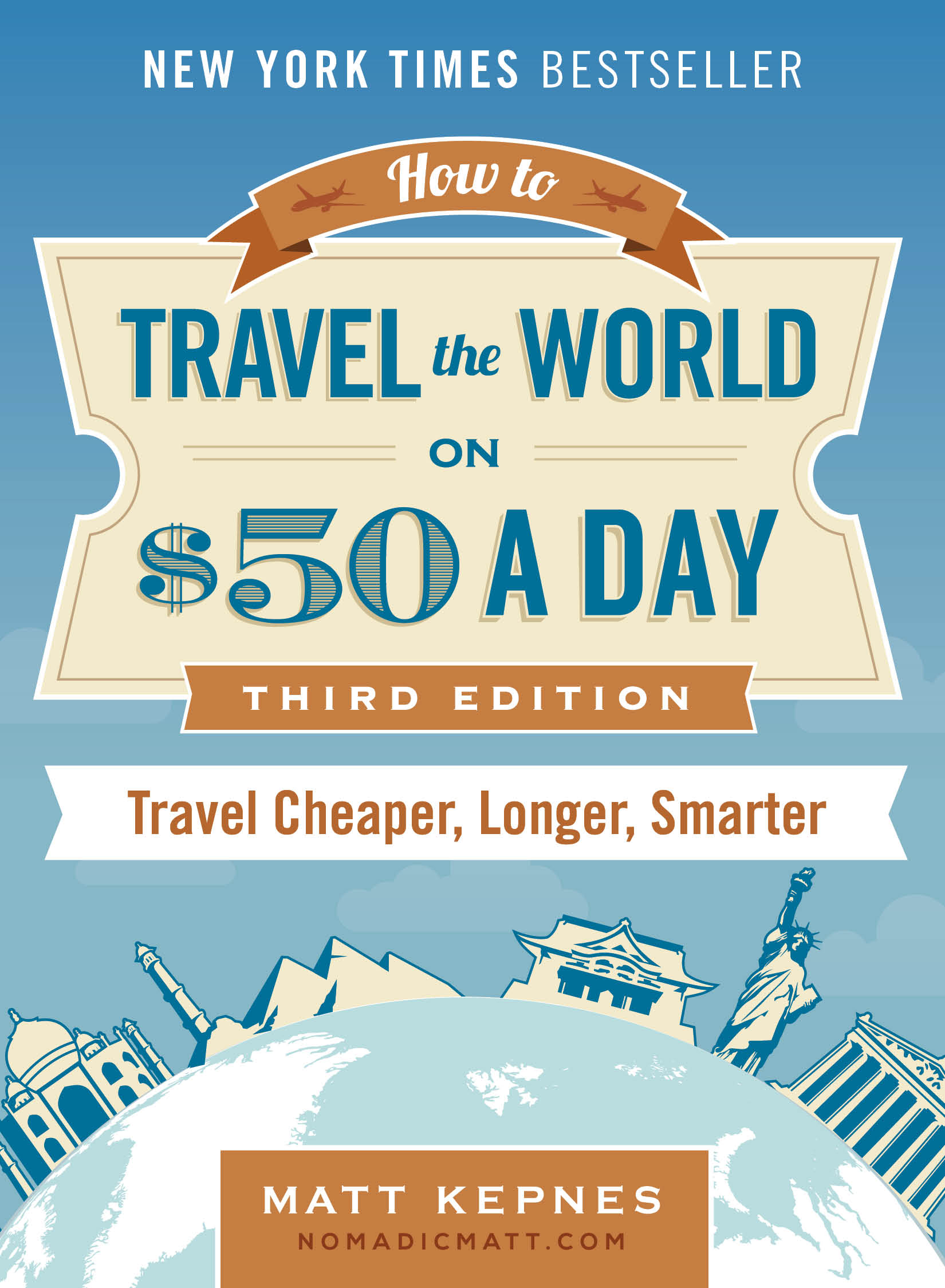 My New York Times best-selling paperback guide to world travel will teach you how to master the art of travel save money, get off the beaten path, and have a more local, richer travel experiences. Click here to learn more about the book, how it can help you, and you can start reading it today!
My New York Times best-selling paperback guide to world travel will teach you how to master the art of travel save money, get off the beaten path, and have a more local, richer travel experiences. Click here to learn more about the book, how it can help you, and you can start reading it today!
Book Your Trip: Logistical Tips and Tricks
Book Your Flight
Find a cheap flight by using Skyscanner or Momondo. They are my two favorite search engines because they search websites and airlines around the globe so you always know no stone is left unturned.
Book Your Accommodation
If you want to stay elsewhere, use Booking.com as they consistently return the cheapest rates for guesthouses and cheap hotels. I use them all the time. You can book your hostel – if you want that instead – with Hostelworld as they have the most comprehensive inventory.
Don’t Forget Travel Insurance
Travel insurance will protect you against illness, injury, theft, and cancellations. It’s comprehensive protection in case anything goes wrong. I never go on a trip without it as I’ve had to use it many times in the past. I’ve been using World Nomads for ten years. My favorite companies that offer the best service and value are:
- World Nomads (for everyone below 70)
- Insure My Trip (for those over 70)
Looking for the best companies to save money with?
Check out my resource page for the best companies to use when you travel! I list all the ones I use to save money when I travel – and I think will help you too!




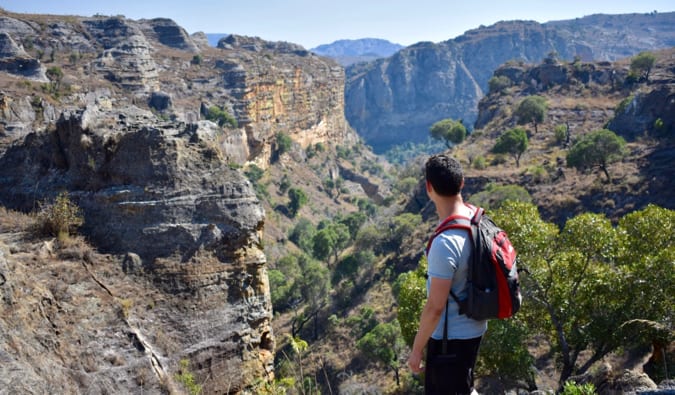
 Lemurs, lemurs, and more lemurs. There’s over 60 species in the country.
Lemurs, lemurs, and more lemurs. There’s over 60 species in the country.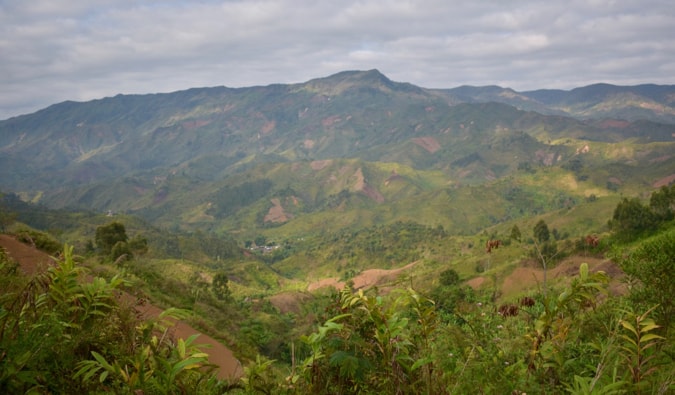 One of the beautiful and lush valleys on the island.
One of the beautiful and lush valleys on the island. The Paradise bird. Just one of the many colorful birds I saw.
The Paradise bird. Just one of the many colorful birds I saw. “King Julien” lemurs (so called because this is the kind that was the character in the movie).
“King Julien” lemurs (so called because this is the kind that was the character in the movie). The poor infrastructure in Madagascar makes the country hard to get around.
The poor infrastructure in Madagascar makes the country hard to get around.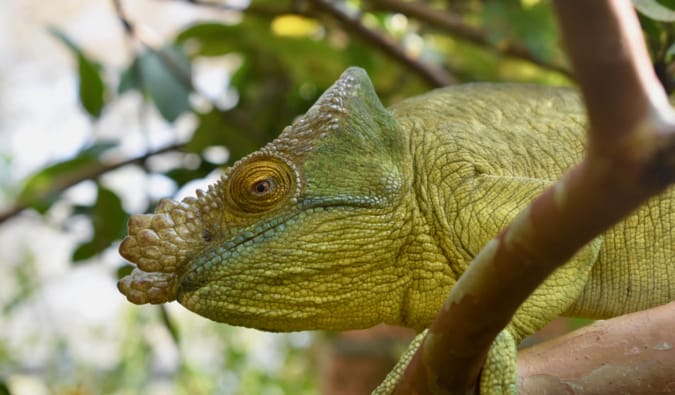 There’s a lot of chameleons here too.
There’s a lot of chameleons here too. Madagascar has this samosa tasting spring roll. I ate them all the time. They made me very happy. Delicious and at three cents each, budget friendly.
Madagascar has this samosa tasting spring roll. I ate them all the time. They made me very happy. Delicious and at three cents each, budget friendly. Baby lemurs!
Baby lemurs! This lemur is actually asleep. It sleeps with its eyes open to deter predators.
This lemur is actually asleep. It sleeps with its eyes open to deter predators. Some of the famous baobab trees.
Some of the famous baobab trees. A beautiful pastel sunset over the capital, Antananarivo!
A beautiful pastel sunset over the capital, Antananarivo!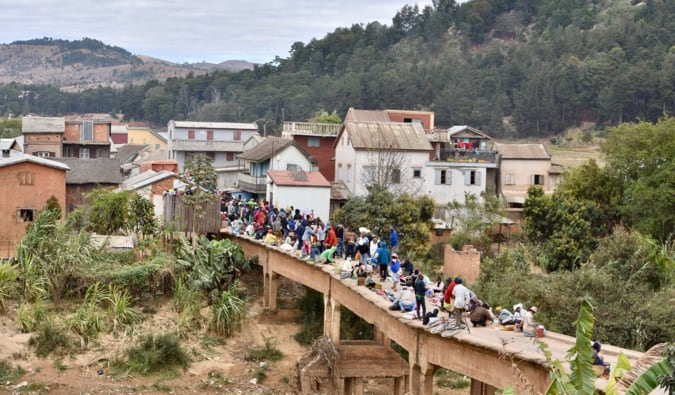 A narrow bridge made even more crowded by a weekly market.
A narrow bridge made even more crowded by a weekly market.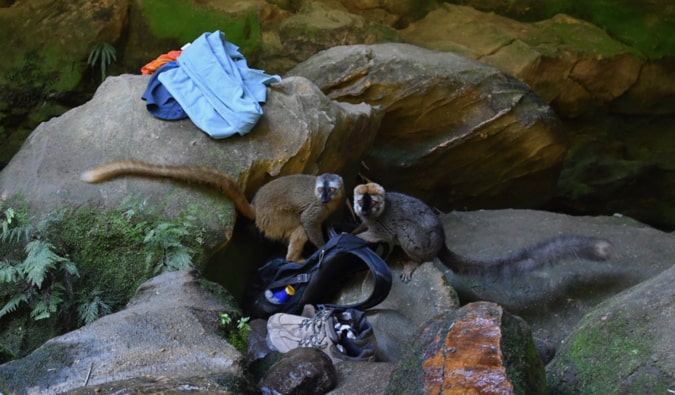 Always be on the lookout for thieves!
Always be on the lookout for thieves! A candid shot!
A candid shot! So many lemurs, so little time.
So many lemurs, so little time. Hiking in Isalo national park, a very Westworld like place.
Hiking in Isalo national park, a very Westworld like place.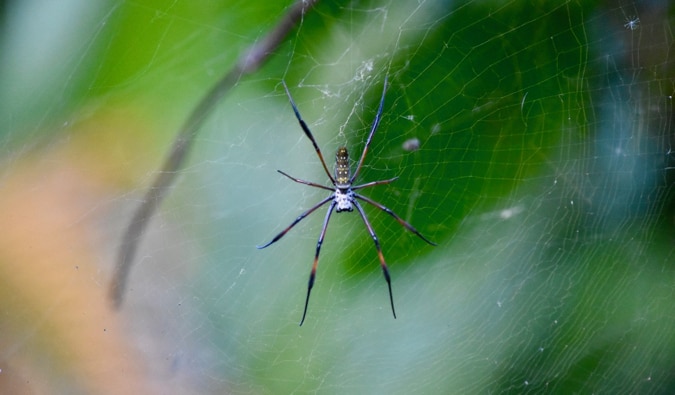 This spider was frighteningly huge.
This spider was frighteningly huge. Taking in the amazing view!
Taking in the amazing view!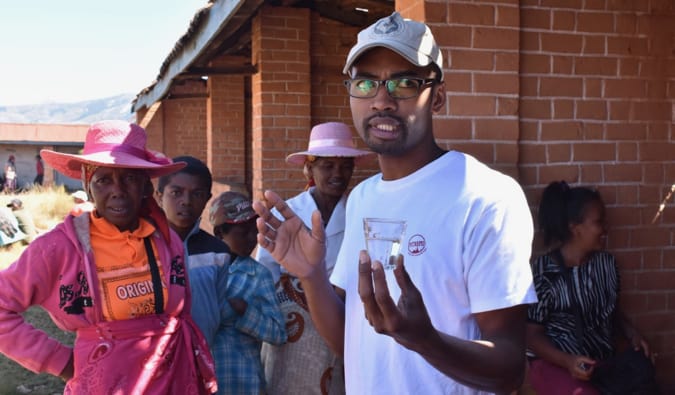 Learning about the country with my awesome guide, Patrick.
Learning about the country with my awesome guide, Patrick.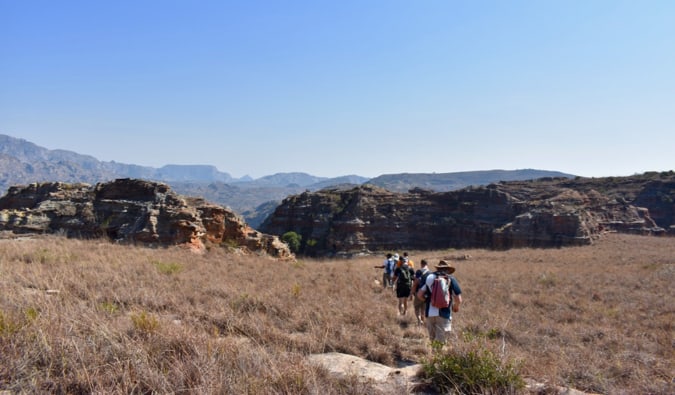 Out for a hike with the Intrepid group.
Out for a hike with the Intrepid group.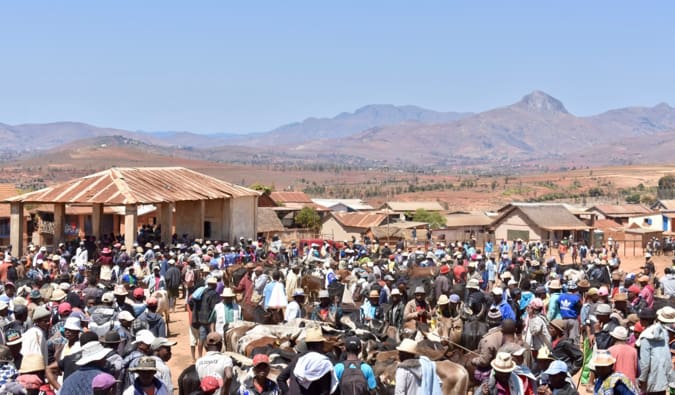 The zebu (a type of cow) market, where people buy and sell cattle.
The zebu (a type of cow) market, where people buy and sell cattle.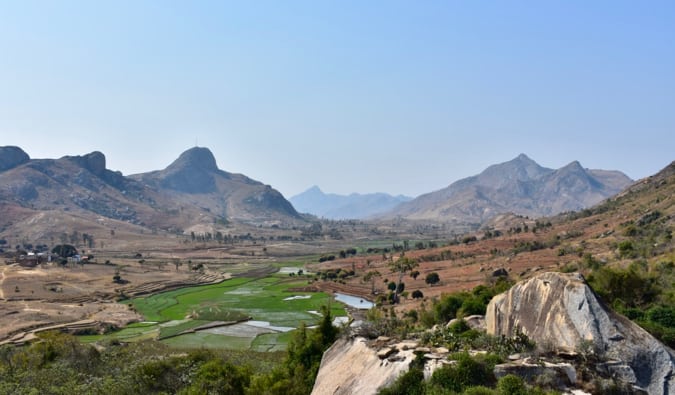 The hills and valleys of Madagascar fill up the long, slow driving days. And they are a wonderful sight.
The hills and valleys of Madagascar fill up the long, slow driving days. And they are a wonderful sight.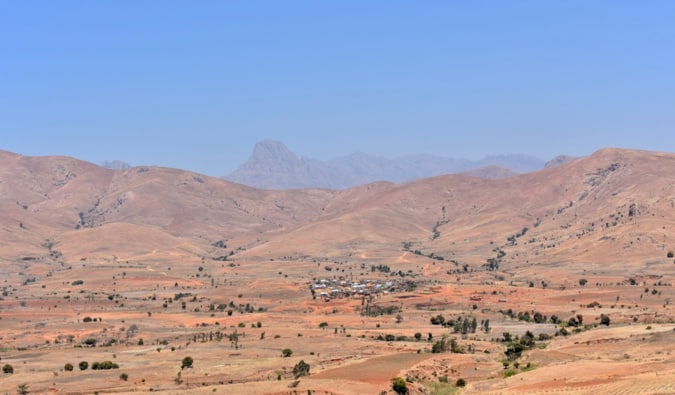 This is what most of Madagascar looks like.
This is what most of Madagascar looks like.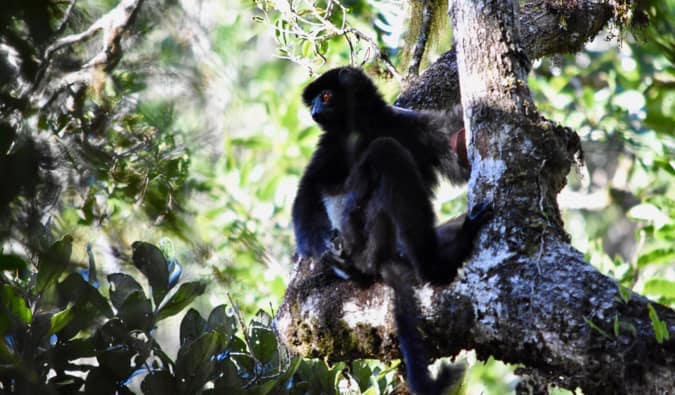 Just another Lemur doing his thing!
Just another Lemur doing his thing! Chatting with my awesome guide Patrick.
Chatting with my awesome guide Patrick.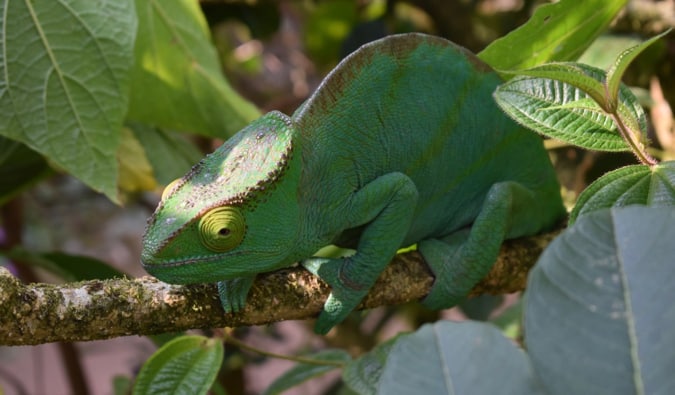 This big fella was just relaxing in the sun.
This big fella was just relaxing in the sun. Home sweet home!
Home sweet home! Taking the classic Instagram picture!
Taking the classic Instagram picture! Ok, one last lemur picture.
Ok, one last lemur picture.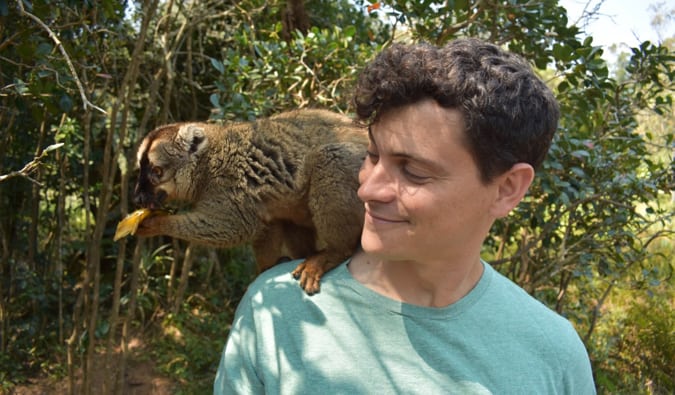 I found my new best friend while in Madagascar!
I found my new best friend while in Madagascar!
 This book shows you how to take money out of the travel equation and and master the points and miles game. It will show you how to easily collect and redeem travel points for free airfare and accommodation so you can get you out of your house faster, cheaper, and in comfort. Click here to learn more about the book and how it can help you, and you can start reading it today!
This book shows you how to take money out of the travel equation and and master the points and miles game. It will show you how to easily collect and redeem travel points for free airfare and accommodation so you can get you out of your house faster, cheaper, and in comfort. Click here to learn more about the book and how it can help you, and you can start reading it today!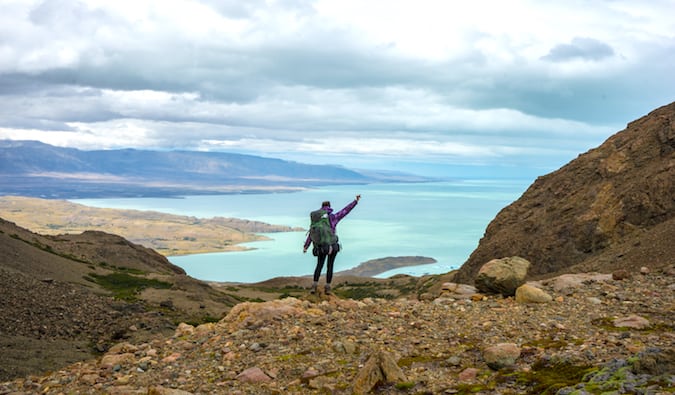
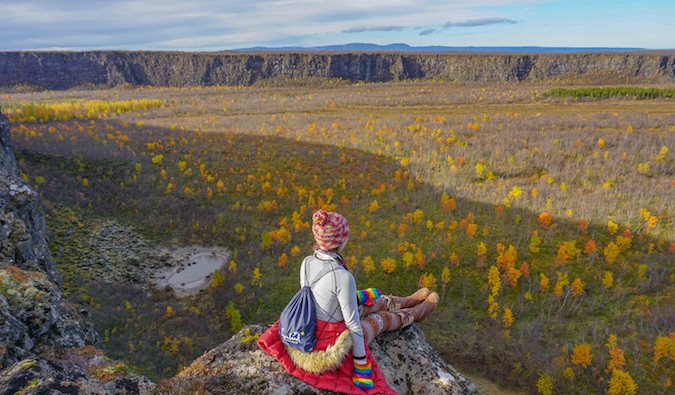

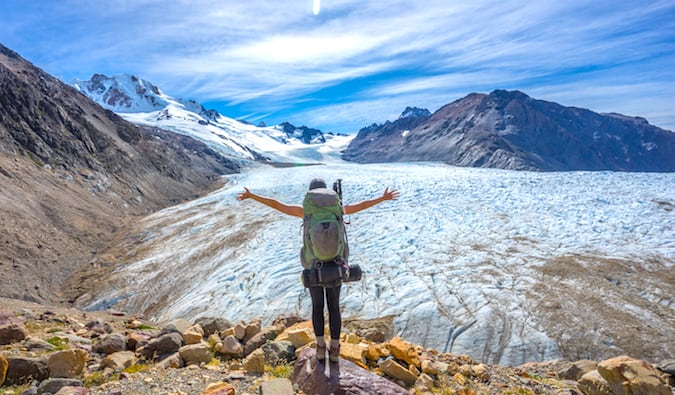
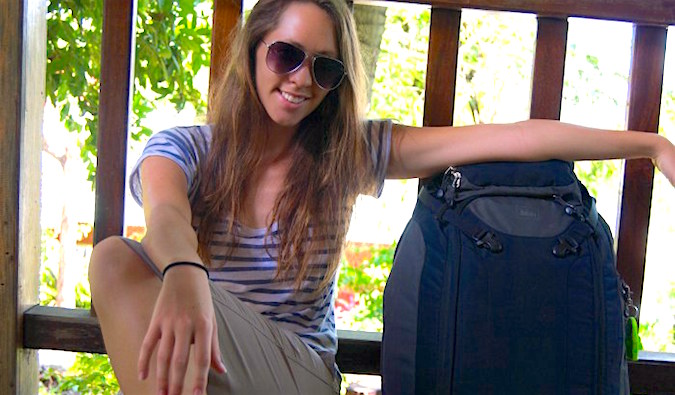
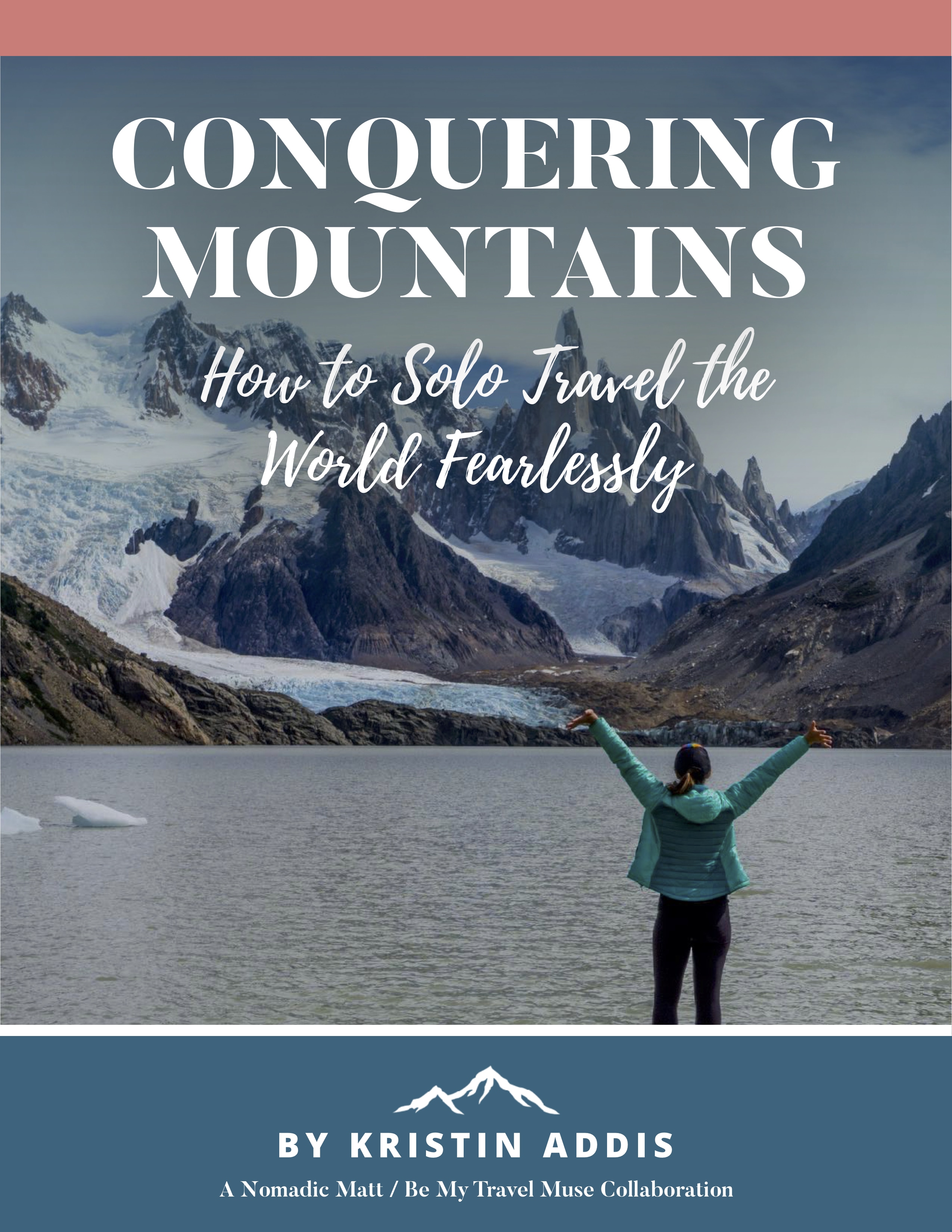 For a complete A-to-Z guide on solo female travel, check out Kristin’s new book, Conquering Mountains. Besides discussing many of the practical tips of preparing and planning your trip, this book addresses the fears, safety, and emotional concerns women have about traveling the world and will help you becaome the traveler you want to be. It features over twenty interviews with other female travel writers and travelers to help you plan better and see more for less.
For a complete A-to-Z guide on solo female travel, check out Kristin’s new book, Conquering Mountains. Besides discussing many of the practical tips of preparing and planning your trip, this book addresses the fears, safety, and emotional concerns women have about traveling the world and will help you becaome the traveler you want to be. It features over twenty interviews with other female travel writers and travelers to help you plan better and see more for less. 